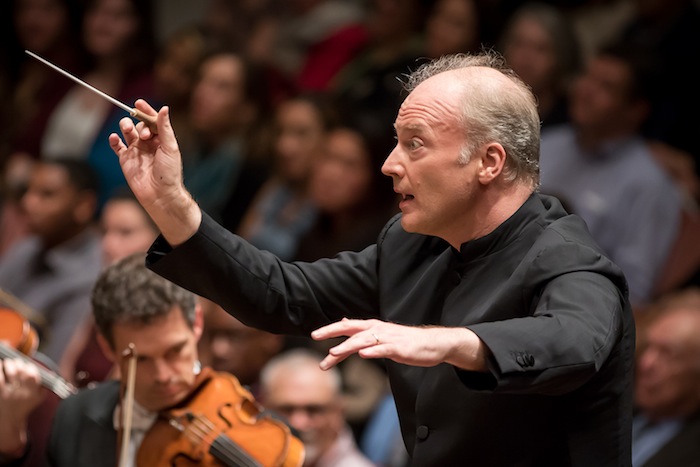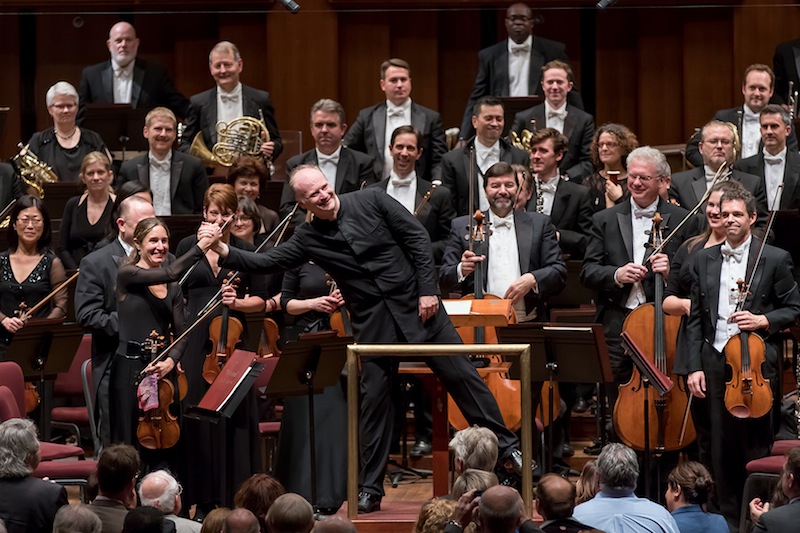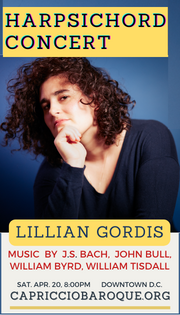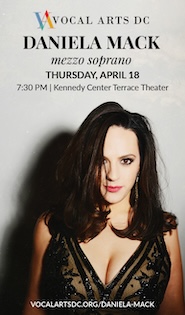Noseda, NSO bring out the steel and serenity of Prokofiev’s “Romeo and Juliet”

Gianandrea Noseda led the National Symphony Orchestra in Prokofiev’s “Romeo and Juliet” Thursday night at the Kennedy Center. Photo: Scott Suchman
Christoph Eschenbach will step down from his post at the National Symphony Orchestra at the end of this season, his seventh as the group’s music director. Eschenbach’s successor will be Gianandrea Noseda, and the Italian conductor is leading two programs with his new ensemble this season. The first, devoted entirely to Prokofiev’s Romeo and Juliet, opened Thursday night in the Kennedy Center Concert Hall, in a concert offered as a tribute to former music director Mstislav Rostropovich.
Noseda approached this ballet music as a symphonic work, not something associated with the movements of dancers. This produced some beautiful results, especially in the fuller sections of the score. Rarely does one get to hear this music with such an immense, pit-bursting complement of musicians. At times Noseda erred on the side of too much volume, though, not taking the same time to calibrate the balances of loud passages as he seemed to have done with more delicate pieces.
Noseda may owe this tendency partially to his apprenticeship years in St. Petersburg with Valery Gergiev. Scenes like “The Street Awakens” and “The Arrival of the Guests” were inexplicably slow and clunky, while others like “The Fight” and “Tybalt and Mercutio Fight” were faster than they needed to be. Some, like Act I’s “Mercutio,” almost came unglued as Noseda’s conducting turned frantic. In the “Folk Dance” that opens Act II and elsewhere, when Noseda tried to micromanage fast tempos, different sections of the orchestra interpreted the beat differently. Ensemble cohesion suffered.
At the same time, that brutality of gesture, reflected in some crushing fortes and occasional wildness in the ensemble, got at the totalitarian bent of the work. Perhaps Noseda was influenced by Leonid Lavrovsky’s choreography for the Mariinsky Theater in St. Petersburg which takes political aim at the imperious aristocrats of Juliet’s family. In the famous “Dance of the Knights,” Juliet’s father dances with two women simultaneously, to the chagrin of his wife. The men hold the women by their wrists, hinting at the violence and depravity that lurks under the household’s surface. As the booming cortege bears the dead body of Tybalt away at the end of Act II, Juliet’s mother grieves a little too excessively, straddling her nephew suggestively on his funeral bier. These moments thrilled most in Noseda’s reading.
When Prokofiev’s music turned silken, Noseda and the musicians responded with velvety cushion in the sound. Principal flutist Aaron Goldman’s many delicate solos captured Juliet’s girlish innocence. Horn principal Abel Pereira was on fire Thursday night, secure throughout the range and stalwart of tone. The only shortcoming in the generally fine brass came in some ragged trumpet entries. It was a treat to hear the music of the balcony scene on an actual organ, rather than the electronic instrument used in most ballet performances, played here by Gary Davison, filling in for organist William Neil.
At the top of a generally ardent and unified string sound was the purring legato tone of the violins. Noseda, in contrast to Eschenbach, generally prefers to keep the first and second violins together on his left side, which benefits this kind of music. The cellos and violas, perhaps used to being hidden more in the ensemble, struggled at times in their more exposed positions, but the serenade moments for solo violin and solo string ensembles were serene. The fragile, tragic music of Act IV featured particularly sublime playing.
Of the three concerts in this season’s “Shakespeare at the Symphony” series, this was the only one that did not include actors reciting selected lines from the source play. Just as well since about a half-hour of Prokofiev’s music, some ten pieces, already had to be cut from the score to keep the evening around two hours in length. Excisions included some of the more exotic pieces, like the “Dance for Mandolins.” Listeners unfamiliar with the ballet could follow the story through a series of projections on a screen over the stage.
Some reservations aside, the prospects for the NSO under Noseda look promising. Cameras were recording last night, and the video captured will be made available for on-demand streaming in the future.
This program will be repeated 8 p.m. Friday and Saturday. kennedy-center.org/calendar/event/NRCSC; 202-467-4600.

Photo: Scott Suchman








Posted Nov 04, 2016 at 6:43 pm by Laura Youens
As always, I learn something from your reviews. Fascinating. Thanks!